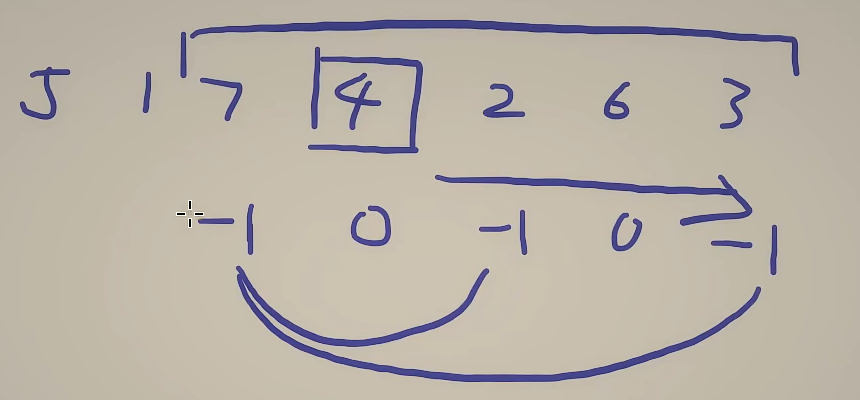第一题:找出中枢整数(6245) 给你一个正整数 n ,找出满足下述条件的 中枢整数 x :
示例 1:
1 2 3 输入:n = 8 1 + 2 + 3 + 4 + 5 + 6 = 6 + 7 + 8 = 21 。
示例 2:
1 2 3 输入:n = 1 1 1 是中枢整数,因为 1 = 1 。
示例 3:
1 2 3 输入:n = 4 1
+++++++++
简单题
我的思路: 通过前缀和,计算数组之间前缀和的差值。
代码为:
1 2 3 4 5 6 7 8 9 10 11 12 13 14 15 16 17 18 19 20 class Solution {public static int pivotInteger (int n) {if (n==1 ) return 1 ;int arr[] = new int [n+1 ];for (int i = 1 ;i<=n;i++){1 ]+i;int i = 1 ;int j = n-1 ;while (i<j){int a = arr[i]-arr[0 ];int b = arr[n]-arr[j];if (a==b && (j-i==1 || i-j==1 )) {return i-j==1 ?i:j;else if (a<b) i++; else j--;return -1 ;
其他思路1: 通过数学的思想,复杂度只需要O(1),太妙了!!
因此,通过以上公式,只需要判断数组中遍历的数是否等于上述公式即可
代码为:
1 2 3 4 5 6 7 8 public static int pivotInteger (int n) {for (int i = 1 ;i<=n;i++){if (i== Math.sqrt(n*(n+1 )/2 )){return i;return -1 ;
其他思路2: 遍历数组,分别以数组中的每个数为中心点,计算该数的左右两边的和,判断是否相等。
代码为:
1 2 3 4 5 6 7 8 9 10 11 12 13 14 class Solution {public static int pivotInteger (int n) {int l = 0 ;int r = 0 ;for (int i = 1 ;i<=n;i++){for (int a = 1 ;a<=i;a++) l+=a;for (int b = i;b<=n;b++) r+=b;if (l==r) return i;0 ;0 ;return -1 ;
第二题:追加字符以获得子序列(6246) 给你两个仅由小写英文字母组成的字符串 s 和 t 。
现在需要通过向 s 末尾追加字符的方式使 t 变成 s 的一个 子序列 ,返回需要追加的最少字符数。
子序列是一个可以由其他字符串删除部分(或不删除)字符但不改变剩下字符顺序得到的字符串。
示例 1:
1 2 3 4 5 输入:s = "coaching" , t = "coding" 4 "ding" ,s = "coachingding" 。t 是 s ("coachingding" ) 的一个子序列。3 个字符都无法使 t 成为 s 的一个子序列。
示例 2:
1 2 3 输入:s = "abcde" , t = "a" 0 t 已经是 s ("abcde" ) 的一个子序列。
示例 3:
1 2 3 4 5 输入:s = "z" , t = "abcde" 5 "abcde" ,s = "zabcde" 。t 是 s ("zabcde" ) 的一个子序列。 4 个字符都无法使 t 成为 s 的一个子序列。
+++++++++++
中等题
思路: 很简单,遍历整个s。t有几个没被匹配上就要添加几个
代码
1 2 3 4 5 6 7 8 9 10 11 12 13 14 class Solution {public static int appendCharacters (String s, String t) {int len1 = s.length();int len2 = t.length();int index = 0 ;for (int i = 0 ;i<len1 && index<len2;){if (s.charAt(i)==t.charAt(index)){else i++;return len2-index;
第三题:从链表中移除节点(6247) 给你一个链表的头节点 head 。
对于列表中的每个节点 node ,如果其右侧存在一个具有 严格更大 值的节点,则移除 node 。
返回修改后链表的头节点 head 。
示例 1:
1 2 3 4 5 6 输入:head = [5 ,2 ,13 ,3 ,8 ]13 ,8 ]5 ,2 和 3 。13 在节点 5 右侧。13 在节点 2 右侧。8 在节点 3 右侧。
示例 2:
1 2 3 输入:head = [1 ,1 ,1 ,1 ]1 ,1 ,1 ,1 ]1 ,所以没有需要移除的节点。
++++++++++
中等题
思路 :使用一个队列维护,使队列中的元素是降序排列。最后从队列中取元素建立链表。
代码
1 2 3 4 5 6 7 8 9 10 11 12 13 14 15 16 17 18 19 20 21 22 23 24 25 26 27 28 29 class Solution {public ListNode removeNodes (ListNode head) {new ArrayDeque <>();ListNode dummy = new ListNode ();ListNode p = head;while ( p!=null ){while (!deque.isEmpty() && deque.peekLast()<p.val) deque.removeLast();while (!deque.isEmpty()){ListNode node = new ListNode (deque.removeFirst());return dummy.next;
其他思路 :递归,从后向前遍历,维护一个最大值(当前节点右边的最大值),如果当前节点小于这个max,则返回当前节点的next,否则返回当前节点。debug可以知道流程
代码
1 2 3 4 5 6 7 8 9 10 11 12 13 14 15 16 17 18 19 20 21 22 23 24 25 26 27 28 29 30 class Solution {private int max;public ListNode removeNodes (ListNode head) {if (head == null ) {return null ;if (head.val < max) {return head.next;else {return head;
第四题 给你一个长度为 n 的数组 nums ,该数组由从 1 到 n 的 不同 整数组成。另给你一个正整数 k 。
统计并返回 num 中的 中位数 等于 k 的非空子数组的数目。
注意:
数组的中位数是按 递增 顺序排列后位于 中间 的那个元素,如果数组长度为偶数,则中位数是位于中间靠 左 的那个元素。
子数组是数组中的一个连续部分。
示例 1:
1 2 3 输入:nums = , k = 4
示例 2:
1 2 3 输入:nums = , k = 3
++++++++
困难题,真难呀
思路: 展开为一个数学公式:
就是中位数==》在奇数的情况下:小于中位数的个数 = 大于中位数的个数
但该题目求得是子数组,所以不能将数组排序,所以将中位数分为左右两侧来看:
中位数左侧小于+中位数右侧小于 = 中位数左侧大于+中位数右侧大于
在计算得过程中,将左右合为一侧:中位数左侧小于 - 中位数左侧大于 = 中位数右侧大于 - 中位数右侧小于(+1-1 = +1-1)
偶数情况下,小于中位数的个数+1 = 大于中位数的个数。
代码
1 2 3 4 5 6 7 8 9 10 11 12 13 14 15 16 17 18 19 20 21 22 23 class Solution {public static int countSubarrays (int [] nums, int k) {int index = 0 ;for (int i = 0 ;i<nums.length;i++){if (nums[i]==k) index = i;new HashMap <>();0 ,1 );int c = 0 ;int res = 0 ;for (int i = index+1 ;i<nums.length;i++){1 :1 ;0 )+1 );0 )+map.getOrDefault(1 ,0 );0 ;for (int i = index-1 ;i>=0 ;i--){1 :-1 ;0 )+map.getOrDefault(c+1 ,0 );return res;


